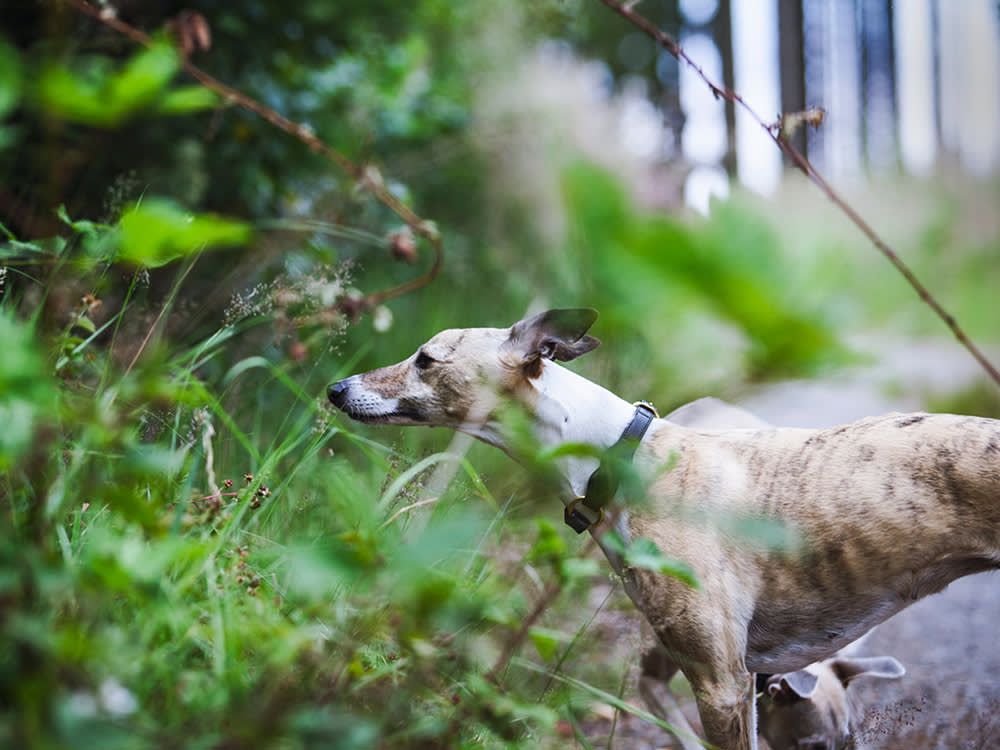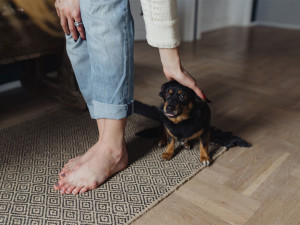What Is Dog Trancing? Why Your Dog Appears Hypnotized By Hanging Objects
When they’re “ghost-walking” outside of Halloween, they could have trance-like syndrome, or TLS.

Share Article
Does your dog seem hypnotized by hanging objects? No, you dangling a piece of bacon over their bowl doesn’t count — anyone would go into a trace from that. This is more about something called trance-like syndrome in dogs. Dog trancing is a behavioral phenomenon in which dogs walk slowly and deliberately under objects that barely touch their backs. It is often described as a “trance-like” state, and dogs may appear to be focused on an object above them. Dog trancing is a harmless behavior in most cases. But if you are ever concerned about your dog’s behavior, it is always best to consult with your veterinarian.
The first time you notice your dog slowly creeping beneath a low-hanging branch or a dangling tablecloth, head moving languorously side-to-side and a far-away look in their eyes, you might worry that it heralds a seizure or points to obsessive-compulsive tendencies. But once the pup has performed this ritual repeatedly with no apparent ill effects to health (theirs) or property (yours), you may simply wonder what causes this hypnosis-like behavior.
In fact, experts say that trance-like syndrome (TLS) — also referred to as “ghost-walking,” “weed-walking,” or simply “trancing” — is usually a benign canine quirk. But why do our furry friends act this way in the presence of low-hanging objects, and are there any situations in which this ritual indicates an illness or behavioral issue?
What is trancing?
Experts refer to the manner in which dogs move while experiencing TLS as “hypokinetic gait,” incredibly slow pacing characterized by soft, deliberate footfalls. This slo-mo walk seems to be stimulated by the dog passing under a plant or fabric hanging at head or back height. In some dogs, the sensation elicits a glassy-eyed gaze and affects the way they position their faces. “Their ears will be completely flat to the head, nose pointed up to the sky and eyes squinted,” veterinarian Dr. Michelle Burch explains.

They may even pause their glacial mosey and stand stock-still for several seconds before resuming their pacing. Uninterrupted, this blissed-out state can last anywhere from several seconds to half an hour but is easily cut short by calling the pup’s name. Although some dogs may briefly exhibit annoyance at being yanked from their reverie, they quickly return to their normal selves.
Is trance-like syndrome a seizure?
Based on current available research, these episodes are not thought to be seizure activity. Dogs with TLS do not have a postictal phase — the time period after a seizure when a dog may be confused, anxious, nauseous, or just off. Unlike a seizure, a TLS “spell” can be easily broken.
Additionally, anti-seizure medication does not prevent a dog from trancing.
Are certain breeds more prone to trance-like syndrome?
Although most common in Bull Terriers and sighthounds (such as Greyhounds and Salukis), TLS has been observed in multiple breeds and mixes. The behavior is also seen more commonly in dogs display symptoms of canine compulsive disorder (CCD) like chasing their tail. It’s possible that there is a genetic component to these behaviors.
Why do dogs trance?
Veterinarians and canine behaviorists are not sure what causes TLS. Seemingly, the light brush of line-drying clothes or foliage against their bodies activates feelings of happiness and tranquility. Some experts consider trancing to be a form of canine compulsive disorder, as many dogs who exhibit TLS are prone to other neurotic behaviors. There’s no conclusive evidence, however, that trancing is connected to a neurological issue.
In most cases, TLS behavior doesn’t mean anything’s wrong with the dog. Trancing behavior can appear strange and pose a mystery to canine experts, but in and of itself, it’s not an indication of health or behavioral problems. “If you do not see any other symptoms associated with trancing episodes,” Dr. Burch says, “I recommend not panicking and allowing them to finish their ritual.”
So, if you spot your pal inching past the coat rack, running their back along jacket bottoms and scarves with a dreamy look on their face, don’t worry. It’s fairly safe to assume that their behavior, though odd, is entirely harmless.
Should you see a vet if your dog is trancing?
If your dog is trancing occasionally and is otherwise normal, there is no need to rush to a vet. Talk to your vet if your dog zones out excessively or is displaying additional symptoms including aggression, head pressing, trouble walking, muscle tremors, pain, vomiting, unresponsiveness to outside stimuli, or sudden unconsciousness. In these cases, your veterinarian may recommend diagnostic testing or a consultation with a veterinary neurologist.
“Dogs who display such symptoms may have an underlying seizure disorder, metabolic abnormalities, or organ dysfunction,” Dr. Burch warns. It’s also a good idea to make certain that a dog’s trance-trigger of choice isn’t potentially damaging to their skin; a “massage” from a poisonous shrub, for example, could produce a painful rash.
How to manage dog trancing
Trancing typically does not indicate a medical problem and does not require treatment. If you’re concerned, you can record one of your dog’s episodes to show your vet during a wellness visit to make sure that they don’t have any concerns. Otherwise, it’s fine to let your dog trance without interruption.
FAQs (People Also Ask)
Should I discourage this behavior?
While a dog’s trancing episodes may be concerning to some pet parents, trancing is considered harmless behavior and does not need to be discouraged. Keep a watchful eye and talk to your vet if you see other behavior changes or symptoms.
Can dog trance become an obsession?
Some dogs may enjoy tiptoeing in a trance-like state, but they are unlikely to become obsessed with the behavior. Dogs with trance-like syndrome may trance weekly to every couple of months.
Resources

Joan Kubicek
Joan Kubicek is a writer, performer, pet-sitter, and dog-mom to a curmudgeonly Terrier named Lyle. She lives in Los Angeles.

Dr. Alycia Washington, DVM, MS
Alycia Washington is a small-animal emergency veterinarian with over 10 years of experience based in North Carolina. She works as a relief veterinarianopens in new tab and provides services to numerous emergency and specialty hospitals. She also works as a veterinary writer with a focus on educating pet parents.
Related articles
![Dog sitting in a tent surrounded by candles and crystals]()
Alternative Therapies Can Zen Out Your Pet, Too
Wellness treatments like acupuncture, Reiki, and sound baths are helping pets heal and bond with their parents.
“Can My Dog Be Trained Not to Dig?”
Stop your dog from digging up your favorite plants with expert advice from animal behaviorist Karen London, PhD.
![Trendy woman in a green coat walking her cute dog in a white jacket in public]()
6 Reasons to Set Boundaries for Your Dog
Well-trained dogs have more freedom (and more fun).
![Reflection of a multi-colored rainbow on the face of a mixed breed dog sitting on the floor indoors]()
What Colors Can Dogs See? How Dog Vision Really Works
Let’s put a stop to this “dogs are totally color blind” myth.
![woman petting small dog that is feeling stressed]()
Stressed Pets: How to Keep Your Dogs Relaxed When Leaving Them Alone
Tips on helping a dog deal with their daily stress.
![Person in a white dress with a calm tan dog leaning on their lap]()
How Dog-Appeasing Pheromones Can Help Dogs Relax
Hey, man. It’s all about those chemical messengers. See how Adaptil can help your pup.








